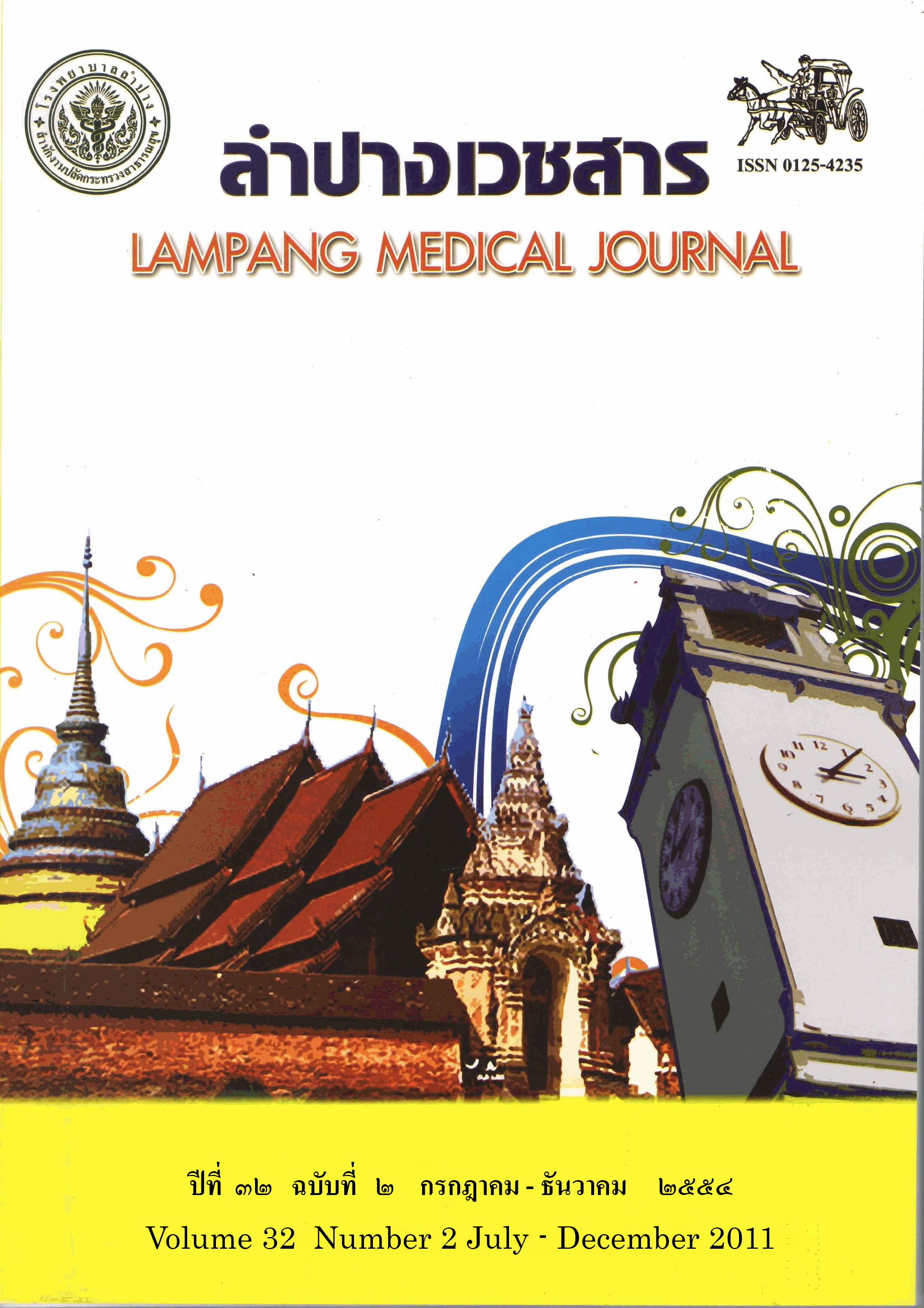Rubber Bulb Syringe Using in Surgery: How to Safely Reuse and Resterilize?
Main Article Content
Abstract
Background : Rubber bulb syringe has been routinely used in many operations. It is commonly reused by manual cleaning and steam sterilization without expiring date. The questions of infective microorganisms and lime scale inside the reservoir remain. There is no previous study about its safety and functional period for surgery.
Objective : To find out the appropriate number of times for reusing rubber bulb syringe in surgery and results of lime scale removal by using vinegar.
Material and method : An experimental research was conducted by use of 50 new rubber bulb syringes, 120 ml-sized, in operating rooms of Lampang Hospital between June and November 2010. Each already-used syringe was manually cleaned by squeezing the bulb with its tip in soapy water and rinsed by squeezing in pipe water. After kept drying in the rack and resterilized by autoclave, they were repeatedly used in surgery for 250 times. Every 5 times of the reuse, one syringe was randomly selected to test its elasticity by manual squeezing. Thirty-ml of sterile normal saline was sucked into the bulb, shook and squeezed out for aerobes culture and turbidity measurement. The bulb was split open to explore the visible lime scale inside and one half was filled with vinegar for 24 hours and tested the fluid turbidity by spectrophotometer. Number of clean wound infection was recorded.
Results : All of the syringes had normal elasticity at the end of testing. No any aerobes positiveculture was found. Forty-nine of the 50 saline specimens (98%) had no turbidity. The split-open bulbs did not show visible lime scale inside. However, after soaking with vinegar for 24 hours, 78% of the analyzed fluid had turbidity >0.01 absorbance unit. Clean wound infection was found in one
diabetes patient whose surgical drain had been unintentionally removed and large hemetoma developed.
Conclusion : Rubber bulb syringe using in surgery could be safely reused at least 250 times by manual cleaning and steam sterilization. The lime scale inside did not cause infection and might be preventable by soaking in vinegar.
Article Details

This work is licensed under a Creative Commons Attribution-NonCommercial-NoDerivatives 4.0 International License.
บทความที่ส่งมาลงพิมพ์ต้องไม่เคยพิมพ์หรือกำลังได้รับการพิจารณาตีพิมพ์ในวารสารอื่น เนื้อหาในบทความต้องเป็นผลงานของผู้นิพนธ์เอง ไม่ได้ลอกเลียนหรือตัดทอนจากบทความอื่น โดยไม่ได้รับอนุญาตหรือไม่ได้อ้างอิงอย่างเหมาะสม การแก้ไขหรือให้ข้อมูลเพิ่มเติมแก่กองบรรณาธิการ จะต้องเสร็จสิ้นเป็นที่เรียบร้อยก่อนจะได้รับพิจารณาตีพิมพ์ และบทความที่ตีพิมพ์แล้วเป็นสมบัติ ของลำปางเวชสาร
References
Baby center medical advisory board. How to use a bulb syringe to clear a stuffy nose. [สืบค้น 27 พฤศจิกายน 2554]. Available from: URL: http://www.babycenter.com/0_how-to-use-a-bulb-syringe-to-clear-a-stuffy-nose_482.bc
Parkland Hospital. Using a bulb syringe. [สืบค้น 27 พฤศจิกายน 2554]. Available from: URL: http://www.parklandhospital.com/patients_visitors/health_information/pdf/IH-IV/IV-94%20Bulb%20Syringe.pdf
Zaslow SA. Removing mineral deposits from household surfaces. North Carolina Cooperative Extension Service. [สืบค้น 27 พฤศจิกายน 2554]. Available from: URL: http://www.bae.ncsu.edu/programs/extension/publicat/wqwm/he397.html
Harrington J. How to remove lime scale. [สืบค้น 27 พฤศจิกายน 2554]. Available from: URL:http://www.ehow.com/how_6694891_remove-lime-scale.html
Ryan P. O.R. and central service questions and answers. Hospital Topics 2010; 61(4):32-7.6. Vatanasapt V, Areemit S, Jeeravipoolvarn P, Kuyyakanond T, Kuptarnond C. Red rubber bulb, cheap and effective vacuum drainage. J Med Assoc Thai 1989; 72(4):193-7.
สมหวัง ด่านชัยวิจิตร. โรคติดเชื้อในโรงพยาบาล. พิมพ์ครั้งที่ 3. กรุงเทพมหานคร: แอลทีเพรส; 2544. หน้า 70.
อะเคื้อ อุณหเลขกะ. การเฝ้าระวังและสอบสวนการระบาดของการติดเชื้อในโรงพยาบาล. พิมพ์ครั้งที่ 1. เชียงใหม่: มิ่งเมืองเชียงใหม่; 2548. หน้า 40.


